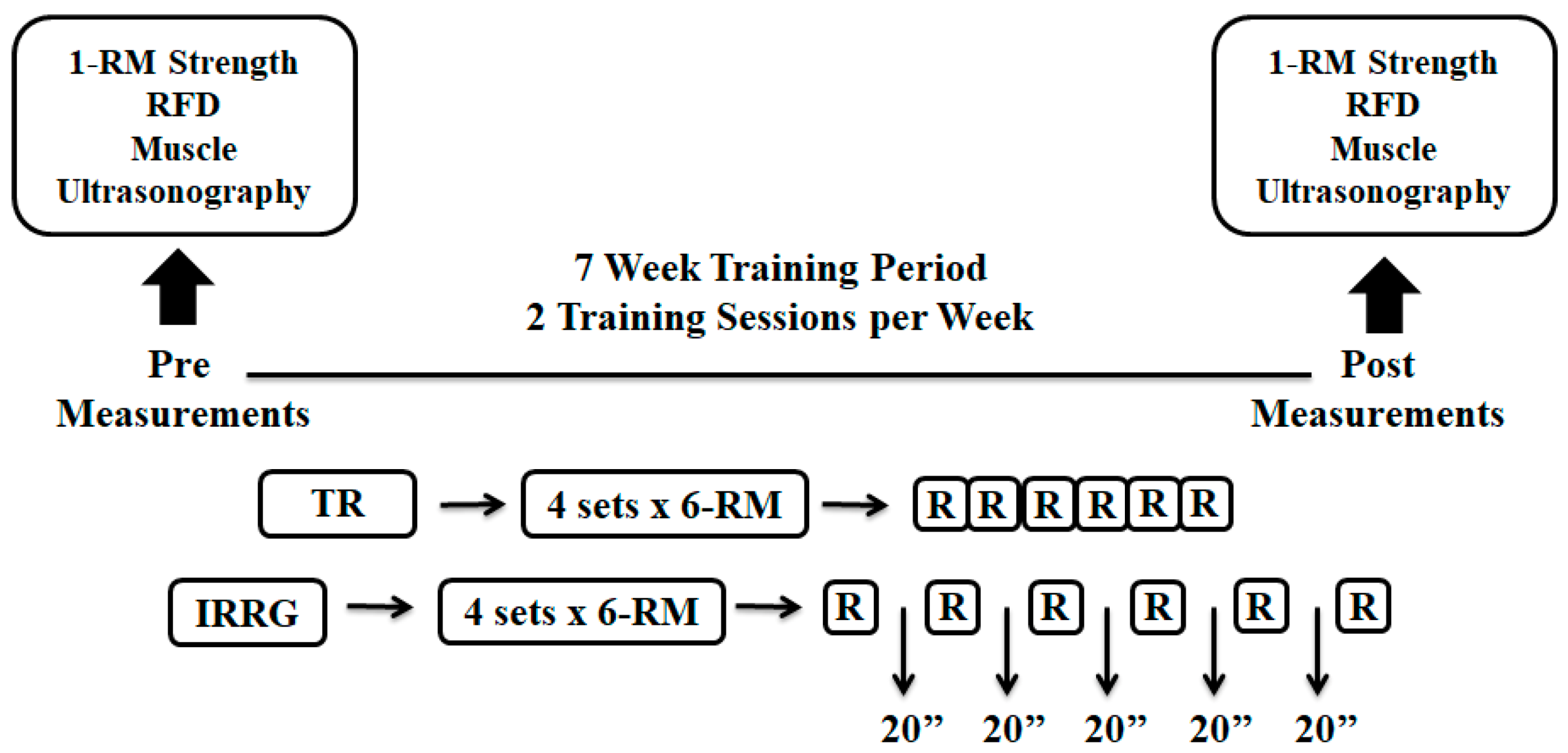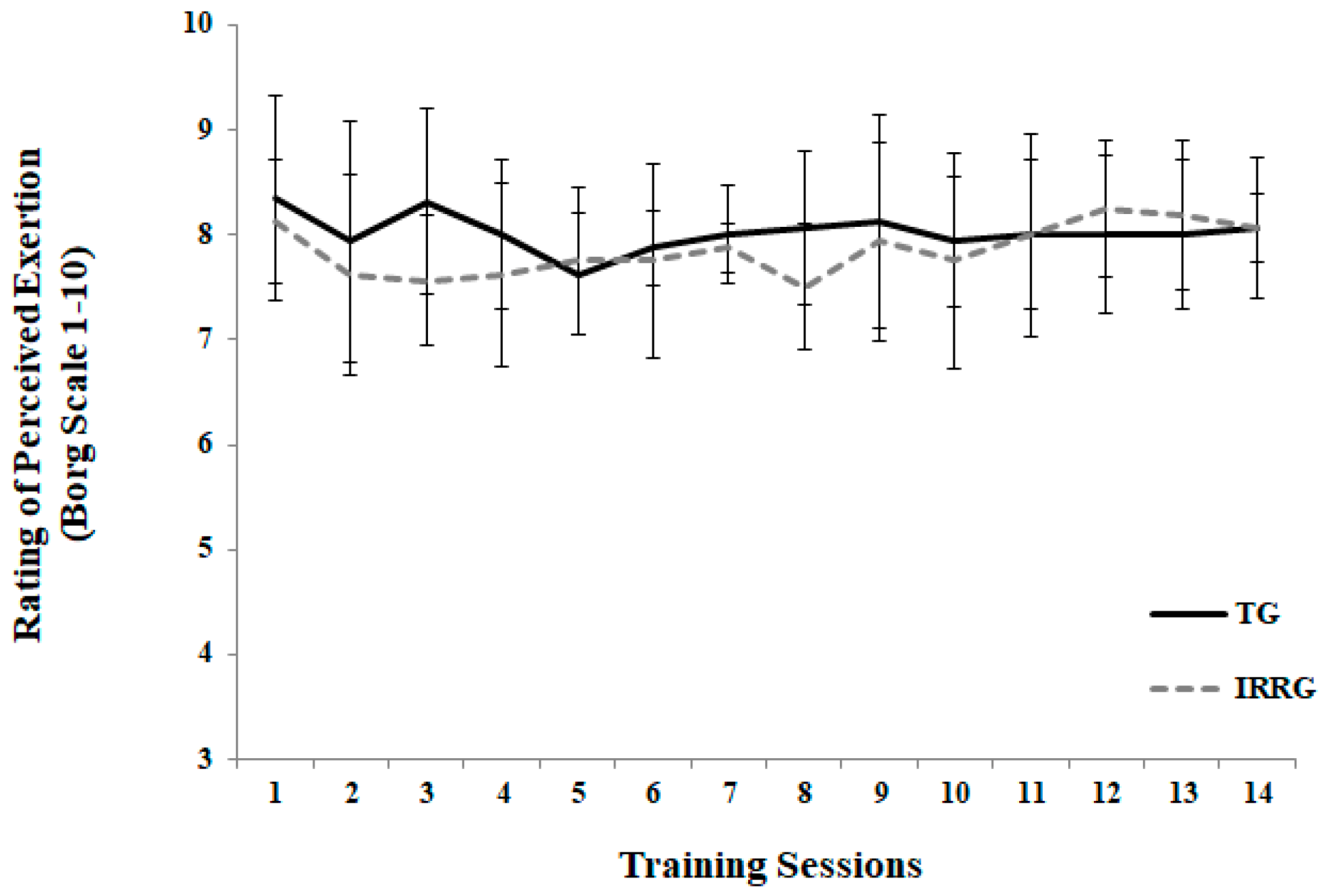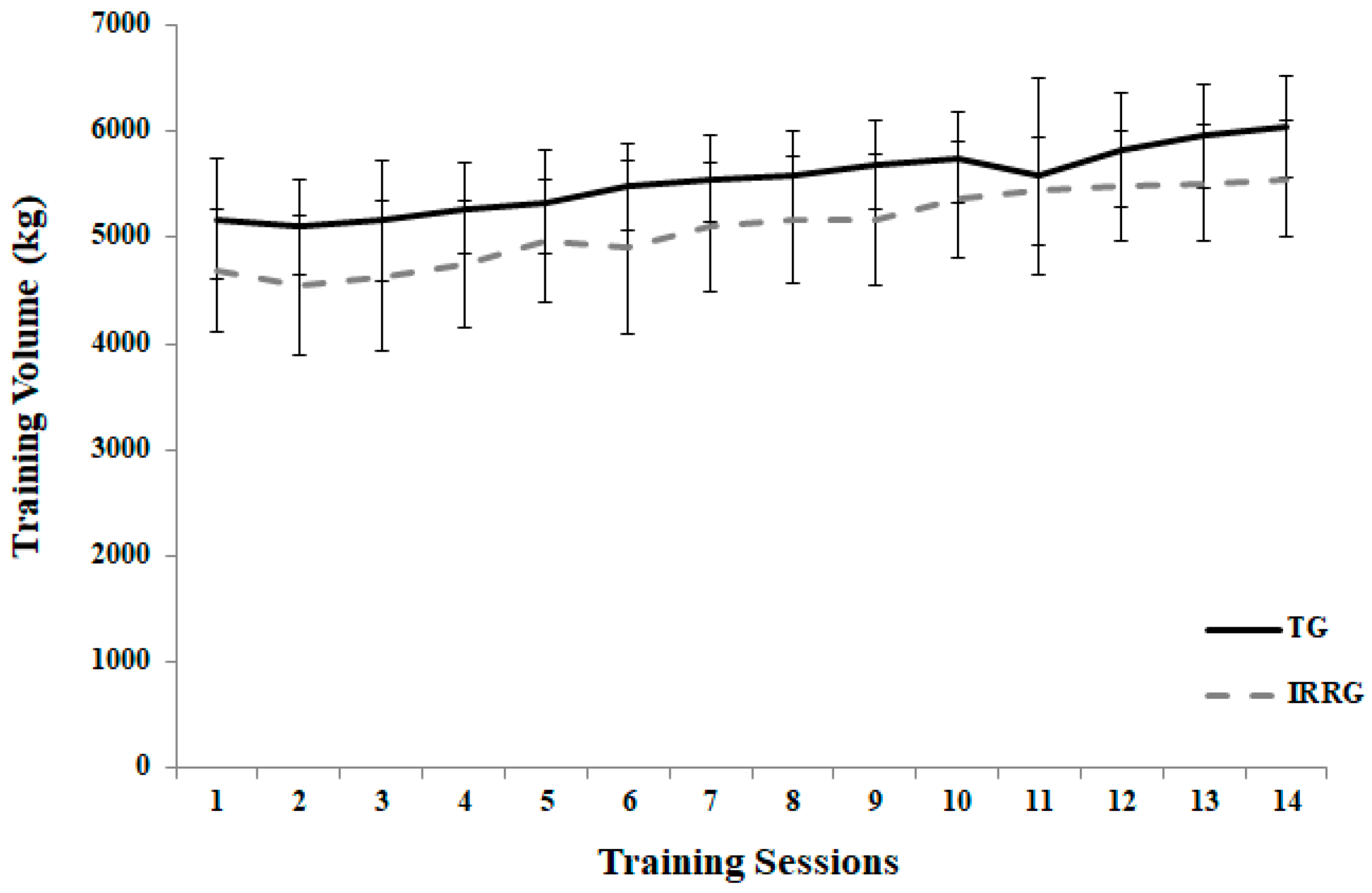Effect of Inter-Repetition Rest vs. Traditional Strength Training on Lower Body Strength, Rate of Force Development, and Muscle Architecture
Abstract
1. Introduction
2. Materials and Methods
2.1. Experimental Design
2.2. Subjects
2.3. Procedures
2.3.1. Training
2.3.2. Leg Press 1-RM Strength
2.3.3. Leg Press Isometric Peak Force and Rate of Force Development
2.3.4. Muscle Ultrasonography
2.4. Statistical Analysis
3. Results
4. Discussion
5. Conclusions
Author Contributions
Funding
Data Availability Statement
Acknowledgments
Conflicts of Interest
References
- Thomas, H.M.; Burns, P.S. Increasing Lean Mass and Strength: A comparison of high frequency strength training to lower frequency strength training. Int. J. Exers. Sci. 2016, 9, 159–167. [Google Scholar]
- Counts, R.B.; Buckner, L.S.; Mouser, J.G.; Dankel, J.S.; Jessee, B.M.; Mattocks, T.K.; Loenneke, J.P. Muscle growth: To infinity and beyond? Muscle Nerve 2017, 56, 1022–1030. [Google Scholar] [CrossRef]
- Iglesias-Soler, E.; Carballeira, E.; Sanchez-Otero, T.; Mayo, X.; Jimenez, A.; Chapman, M.L. Acute effects of distribution of rest between repetitions. Int. J. Sports Med. 2012, 33, 351–358. [Google Scholar] [CrossRef]
- Nicholson, G.; Ispoglou, T.; Bissas, A. The impact of repetition mechanics on the adaptations resulting from strength-, hypertrophy- and cluster-type resistance training. Eur. J. Appl. Physiol. 2016, 116, 1875–1888. [Google Scholar] [CrossRef]
- Gorostiaga, E.M.; Navarro-Amèzqueta, I.; Calbet, J.A.L.; Sánchez-Medina, L.; Cusso, R.; Guerrero, M.; Granados, C.; González-Izal, M.; Ibáñez, J.; Izquierdo, M. Blood ammonia and lactate as markers of muscle metabolites during leg press exercise. J. Strength Cond. Res. 2014, 28, 2775–2785. [Google Scholar] [CrossRef] [PubMed]
- Taylor, J.L.; Amann, M.; Duchateau, J.; Meeusen, R.; Rice, C.L. Neural Contributions to Muscle Fatigue: From the Brain to the Muscle and Back Again. Med. Sci. Sports Exerc. 2016, 48, 2294–2306. [Google Scholar] [CrossRef] [PubMed]
- Tufano, J.J.; Brown, L.E.; Haff, G.G. Theoretical and practical aspects of different cluster set structures: A systematic review. J. Strength Cond. Res. 2017, 31, 848–867. [Google Scholar] [CrossRef] [PubMed]
- Haff, G.G.; Hobbs, R.T.; Haff, E.E.; Sands, W.A.; Pierce, K.C.; Stone, M.H. Cluster training: A novel method for introducing training program variation. Strength Cond. J. 2008, 30, 67–76. [Google Scholar] [CrossRef]
- Mora-Custodio, R.; Rodríguez-Rosell, D.; Yáñez-García, J.M.; Sánchez-Moreno, M.; Pareja-Blanco, F.; González-Badillo, J.J. Effect of different inter-repetition rest intervals across four load intensities on velocity loss and blood lactate concentration during full squat exercise. J. Sports Sci. 2018, 36, 2856–2864. [Google Scholar] [CrossRef] [PubMed]
- Rial-Vázquez, J.; Mayo, X.; Tufano, J.J.; Fariñas, J.; Rúa-Alonso, M.; Iglesias-Soler, E. Cluster vs. traditional training programs: Changes in the force–velocity relationship. Sports Biomech. 2020, 5, 1–19. [Google Scholar] [CrossRef]
- Iglesias, E.; Boullosa, D.A.; Dopico, X.; Carballeira, E. Analysis of factors that influence the maximum number of repetitions in two upper-body resistance exercises: Curl biceps and bench press. J. Strength Cond. Res. 2010, 24, 1566–1572. [Google Scholar] [CrossRef] [PubMed]
- Iglesias-Soler, E.; Carballeira, E.; Sanchez-Otero, T.; Mayo, X.; Fernandez-Del-Olmo, M. Performance of maximum number of repetitions with cluster set configuration. Int. J. Sports Physiol. Perf. 2014, 9, 637–642. [Google Scholar] [CrossRef] [PubMed]
- Oliver, J.M.; Jagim, A.R.; Sanchez, A.C.; Mardock, M.A.; Kelly, K.A.; Meredith, H.J.; Smith, G.L.; Greenwood, M.; Parker, J.L.; Riechman, S.E.; et al. Greater gains in strength and power with intraset rest intervals in hypertrophic training. J. Strength Cond. Res. 2013, 27, 3116–3131. [Google Scholar] [CrossRef] [PubMed]
- Oliver, J.M.; Kreutzer, A.; Jenke, S.; Phillips, M.D.; Mitchell, J.B.; Jones, M.T. Acute response to cluster sets in trained and untrained men. Eur. J. Appl. Physiol. 2015, 15, 2383–2393. [Google Scholar] [CrossRef]
- Hansen, K.T.; Cronin, J.B.; Pickering, S.L.; Newton, M.J. Does cluster loading enhance lower body power development in preseason preparation of elite rugby union players? J. Strength Cond. Res. 2011, 25, 2118–2126. [Google Scholar] [CrossRef]
- Zarezadeh-Mehrizi, A.; Aminai, M.; Amiri-khorasani, M. Effects of traditional and cluster resistance training on explosive power in soccer players. Iranian J. Health Phys. Act. 2013, 4, 51–56. [Google Scholar]
- Iglesias-Soler, E.; Mayo, X.; Río-Rodríguez, D.; Carballeira, E.; Fariñas, F.; Fernández-Del-Olmo, F. Inter-repetition rest training and traditional set configuration produce similar strength gains without cortical adaptations. J. Sports Sci. 2015, 34, 1473–1484. [Google Scholar] [CrossRef]
- Sale, D.G. Neural Adaptations to Strength Training. In Strength and Power in Sport, 2nd ed.; Komi, P.V., Ed.; Blackwell Science Ltd.: Oxford, UK, 2003; pp. 281–314. [Google Scholar]
- Maffiuletti, N.A.; Aagaard, P.; Blazevich, A.J.; Folland, J.; Tillin, N.; Duchateau, J. Rate of force development: Physiological and methodological considerations. Eur. J. Appl. Physiol. 2016, 116, 1091–1116. [Google Scholar] [CrossRef]
- Blazevich, A.J.; Wilson, C.J.; Alcaraz, P.E.; Rubio-Arias, J.A. Effects of Resistance Training Movement Pattern and Velocity on Isometric Muscular Rate of Force Development: A Systematic Review with Meta-analysis and Meta-regression. Sports Med. 2020, 50, 943–963. [Google Scholar] [CrossRef]
- Zaras, N.D.; Stasinaki, A.-N.E.; Methenitis, S.K.; Krase, A.A.; Karampatsos, G.P.; Georgiadis, G.V.; Terzis, G. Rate of force development, muscle architecture, and performance in young competitive track and field throwers. J. Strength Cond. Res. 2016, 30, 81–92. [Google Scholar] [CrossRef]
- Zaras, N.D.; Stasinaki, A.-N.E.; Krase, A.A.; Methenitis, S.K.; Karampatsos, G.P.; Georgiadis, G.V.; Spengos, K.M.; Terzis, G.D. Effects of tapering with light vs. heavy loads on track and field throwing performance. J. Strength Cond. Res. 2014, 28, 3484–3495. [Google Scholar] [CrossRef]
- Davies, T.B.; Halaki, M.; Orr, R.; Helms, E.R.; Hackett, D.A. Changes in bench press velocity and power after 8 weeks of high-load cluster or traditional-set structures. J. Strength Cond. Res. 2019, 34, 2734–2742. [Google Scholar] [CrossRef] [PubMed]
- Ruiz-Cárdenasa, J.D.; Rodríguez-Juana, J.J.; Ríos-Díaza, J. Relationship between jumping abilities and skeletal muscle architecture of lower limbs in humans: Systematic review and meta-analysis. Hum. Mov. Sci. 2018, 58, 10–20. [Google Scholar] [CrossRef] [PubMed]
- Stasinaki, A.-N.; Zaras, N.; Methenitis, S.; Bogdanis, G.; Terzis, G. Rate of force, development and muscle architecture after fast and slow velocity eccentric training. Sports 2019, 7, 41. [Google Scholar] [CrossRef] [PubMed]
- Zaras, N.; Stasinaki, A.-N.; Methenitis, S.K.; Karampatsos, G.P.; Fatouros, I.; Hadjicharalambous, M.; Terzis, G. Track and field throwing performance prediction: Training intervention, muscle architecture adaptations and field tests explosiveness ability. J. Phys. Educ. Sport. 2019, 19, 436–443. [Google Scholar] [CrossRef]
- Aagaard, P.; Andersen, L.J.; Dyhre-Poulsen, P.; Leffers, M.A.; Wagner, A.; Magnusson, P.S.; Kristensen, H.J.; Simonsen, B.E. A mechanism for increase contractile strength of human pennate muscle in response to strength training: Changes in muscle architecture. J. Physiol. 2001, 534, 613–623. [Google Scholar] [CrossRef] [PubMed]
- Cormie, P.; McGuigan, M.R.; Newton, R.U. Adaptations in athletic performance after ballistic power versus strength training. Med. Sci. Sports Exerc. 2010, 42, 1582–1598. [Google Scholar] [CrossRef]
- Stasinaki, A.-N.; Gloumis, G.; Spengos, K.; Blazevich, A.J.; Zaras, N.; Georgiadis, G.; Karampatsos, G.; Terzis, G. Muscle strength, power, and morphologic adaptations after 6 weeks of compound vs. complex training in healthy men. J. Strength Cond. Res. 2015, 29, 2559–2569. [Google Scholar] [CrossRef]
- Alonso-Fernandez, D.; Docampo-Blanco, P.; Martinez-Fernandez, J. Changes in muscle architecture of biceps femoris induced by eccentric strength training with nordic hamstring exercise. Scand. J. Med. Sci. Sports 2018, 28, 88–94. [Google Scholar] [CrossRef]
- Zacharia, E.; Spiliopoulou, P.; Methenitis, S.; Stasinaki, A.-N.; Zaras, N.; Papadopoulos, C.; Papadimas, G.; Karampatsos, G.; Bogdanis, G.; Terzis, G. Changes in muscle power and muscle morphology with different volumes of fast eccentric half-squats. Sports 2019, 7, 164. [Google Scholar] [CrossRef]
- Hardee, J.P.; Triplett, N.T.; Utter, A.C.; Zwetsloot, K.A.; Mcbride, J.M. Effect of interrepetition rest on power output in the power clean. J. Strength Cond. Res. 2012, 26, 883–889. [Google Scholar] [CrossRef] [PubMed]
- Borg, G.A. Psychophysical bases of perceived exertion. Med. Sci. Sports Exerc. 1982, 5, 377–381. [Google Scholar] [CrossRef]
- Day, M.L.; McGuigan, M.R.; Brice, G.; Foster, C. Monitoring exercise intensity during resistance training using the session RPE scale. J. Strength Cond. Res. 2004, 18, 353–358. [Google Scholar] [CrossRef]
- Sweet, T.W.; Foster, C.; McGuigan, M.R.; Brice, G. Quantitation of resistance training using the session rating of perceived exertion method. J. Strength Cond. Res. 2004, 18, 796–802. [Google Scholar] [CrossRef] [PubMed]
- Zaras, N.; Stasinaki, A.N.; Spiliopoulou, P.; Arnaoutis, G.; Hantjicharalambous, M.; Terzis, G. Rate of force development, muscle architecture and performance in elite weightlifters. Inter. J. Sports Phys. Perf. 2020. Ahead of Print. [Google Scholar] [CrossRef]
- Aagaard, P.; Simonsen, E.B.; Andersen, J.L.; Magnusson, P.; Duhre-Poulsen, P. Increase rate of force development and neural drive of human skeletal muscle following resistance training. J. Appl. Physiol. 2002, 93, 1318–1326. [Google Scholar] [CrossRef]
- Blazevich, A.J.; Gill, N.D.; Zhou, S. Intra- and intermuscular variation in human quadriceps femoris architecture assessed in vivo. J. Anat. 2006, 209, 289–310. [Google Scholar] [CrossRef]
- Tsitkanou, S.; Spengos, K.; Stasinaki, A.-N.; Zaras, N.; Bogdanis, G.; Papadimas, G.; Terzis, G. Effects of high-intensity interval cycling performed after resistance training on muscle strength and hypertrophy. Scand. J. Med. Sci. Sports 2017, 27, 1317–1327. [Google Scholar] [CrossRef]
- Noorkoiv, M.; Stavnsbo, A.; Aagaard, P.; Blazevich, A. In Vivo assessment of muscle fascicle length by extended field-of-view ultrasonography. J. Appl. Physiol. 2010, 109, 1974–1979. [Google Scholar] [CrossRef]
- Noorkoiv, M.; Nosaka, K.; Blazevich, A.J. Assessment of quadriceps muscle cross-section area by ultrasound extended-field-of-view imaging. Eur. J. Appl. Physiol. 2010, 109, 631–639. [Google Scholar] [CrossRef]
- Andersen, L.J.; Aagaard, P. Myosin heavy chain IIX overshoot in human skeletal muscle. Muscle Nerve 2000, 23, 1095–1104. [Google Scholar] [CrossRef]
- Blazevich, A.J.; Cannavan, D.; Coleman, D.R.; Horne, S. Influence of concentric and eccentric resistance training on architectural adaptation in human quadriceps muscles. J. Appl. Physiol. 2007, 103, 1565–1575. [Google Scholar] [CrossRef] [PubMed]
- Schoenfeld, B.J.; Ogborn, D.; Krieger, J.W. Dose response relationship between weekly resistance training volume and increases in muscle mass: A systematic review and meta-analysis. J. Sports Sci. 2016, 35, 1079–1082. [Google Scholar] [CrossRef] [PubMed]



| Traditional Group | Inter-Repetition Rest Group | % Difference between Groups | ||||||||||
|---|---|---|---|---|---|---|---|---|---|---|---|---|
| Measurement | Pre | Post | Change (%) | Sig. | η2 | Pre | Post | Change (%) | Sig. | η2 | Sig. | η2 |
| Body mass (kg) | 79.5 ± 12.8 | 79.8 ± 13.8 | 0.23 ± 2.1 | 0.556 | 0.025 | 75.7 ± 8.4 | 76.5 ± 7.8 | 1.2 ± 1.5 | 0.120 | 0.160 | 0.308 | 0.074 |
| Leg press 1-RM (kg) | 261.3 ± 26.6 | 312.5 ± 18.32 * | 20.4 ± 10.8 | 0.000 | 0.835 | 237.5 ± 30.5 | 285.0 ± 30.7 * | 20.4 ± 5.9 | 0.000 | 0.814 | 0.997 | 0.000 |
| RFD30ms (N·s−1) | 16,177 ± 7400 | 14,397 ± 8383 | −3.3 ± 14.5 | 0.488 | 0.038 | 9242 ± 4803 | 11,384 ± 2910 | 43.6 ± 56.8 # | 0.358 | 0.065 | 0.016 | 0.350 |
| RFD50ms (N·s−1) | 18,299 ± 5656 | 16,587 ± 7352 | −1.1 ± 16.6 | 0.796 | 0.005 | 11,345 ± 5622 | 14,320 ± 4355 | 44.3 ± 58.9 # | 0.376 | 0.061 | 0.023 | 0.323 |
| RFD80ms (N·s−1) | 18,227 ± 3977 | 17,411 ± 5884 | −5.9 ± 15.1 | 0.899 | 0.001 | 12,587 ± 5258 | 15,378 ± 4391 | 33.4 ± 47.3 # | 0.329 | 0.073 | 0.042 | 0.263 |
| RFD100ms (N·s−1) | 17,257 ± 3340 | 17,030 ± 5181 | −2.6 ± 14.6 | 0.760 | 0.007 | 12,611 ± 4470 | 15,041 ± 4048 | 26.4 ± 39.2 | 0.269 | 0.093 | 0.070 | 0.216 |
| RFD150ms (N·s−1) | 14,415 ± 2451 | 14,424 ± 3438 | −0.7 ± 10.4 | 0.775 | 0.007 | 11,302 ± 3084 | 12,854 ± 3124 | 16.6 ± 25.2 | 0.188 | 0.129 | 0.095 | 0.186 |
| RFD200ms (N·s−1) | 11,985 ± 1900 | 12,240 ± 2451 | 1.9 ± 10.6 | 0.516 | 0.033 | 9746 ± 2399 | 10,691 ± 2405 | 11.5 ± 19.4 | 0.217 | 0.115 | 0.240 | 0.097 |
| RFD250ms (N·s−1) | 10,041 ± 1480 | 10,600 ± 1933 | 5.6 ± 12.6 | 0.150 | 0.153 | 8384 ± 2050 | 9146 ± 1832 | 11.3 ± 18.4 | 0.221 | 0.113 | 0.483 | 0.035 |
| IPF (kgN) | 3119 ± 529 | 3498 ± 628 * | 12.3 ± 8.7 | 0.001 | 0.547 | 2721 ± 660 | 3178 ± 759 * | 17.4 ± 8.5 | 0.000 | 0.638 | 0.260 | 0.089 |
| Traditional Group | Inter-Repetition Rest Group | % Difference between Groups | ||||||||||
|---|---|---|---|---|---|---|---|---|---|---|---|---|
| Measurement | Pre | Post | Change (%) | Sig. | η2 | Pre | Post | Change (%) | Sig. | η2 | Sig. | η2 |
| VL thickness (cm) | 2.6 ± 0.4 | 2.7 ± 0.4 * | 4.8 ± 7.5 | 0.043 | 0.262 | 2.5 ± 0.3 | 2.6 ± 0.2 | 4.9 ± 5.2 | 0.048 | 0.260 | 0.983 | 0.000 |
| VL length (cm) | 8.7 ± 1.6 | 8.4 ± 1.6 | −3.9 ± 5.4 | 0.078 | 0.205 | 8.3 ± 0.9 | 8.7 ± 1.1 * | 4.8 ± 6.1 # | 0.044 | 0.260 | 0.009 | 0.393 |
| VL angle (°) | 19.1 ± 1.7 | 19.7 ± 3.4 | 3.1 ± 10.7 | 0.366 | 0.059 | 18.1 ± 1.1 | 18.1 ± 1.5 | 0.4 ± 10.2 | 0.983 | 0.000 | 0.618 | 0.018 |
| VΙ thickness (cm) | 2.1 ± 0.3 | 2.2 ± 0.3 | 1.3 ± 11.3 | 0.813 | 0.004 | 1.9 ± 0.4 | 2.1 ± 0.4 | 3.0 ± 5.7 | 0.442 | 0.043 | 0.711 | 0.000 |
| VL and VΙ Combined Thickness (cm) | 4.7 ± 0.5 | 4.8 ± 0.5 * | 3.2 ± 4.0 | 0.013 | 0.365 | 4.4 ± 0.6 | 4.6 ± 0.5 * | 3.8 ± 3.0 | 0.010 | 0.387 | 0.735 | 0.000 |
| VL CSA (cm2) | 18.9 ± 4.9 | 21.8 ± 5.3 * | 16.7 ± 12.7 | 0.004 | 0.458 | 16.9 ± 3.0 | 20.7 ± 3.9 * | 23.4 ± 17.9 | 0.000 | 0.599 | 0.409 | 0.049 |
| VI CSA (cm2) | 26.4 ± 3.2 | 29.5 ± 3.1 * | 12.1 ± 9.6 | 0.013 | 0.367 | 26.5 ± 5.7 | 30.9 ± 8.8 * | 15.7 ± 9.6 | 0.001 | 0.548 | 0.469 | 0.038 |
| RF CSA (cm2) | 9.6 ± 1.6 | 9.7 ± 1.3 | 0.8 ± 4.8 | 0.943 | 0.000 | 11.0 ± 2.5 | 11.7 ± 3.6 | 5.7 ± 14.7 | 0.104 | 0.177 | 0.393 | 0.053 |
| VM CSA (cm2) | 10.3 ± 1.4 | 12.3 ± 1.7 * | 19.7 ± 11.5 | 0.003 | 0.468 | 11.6 ± 3.3 | 12.6 ± 4.3 | 7.8 ± 18.2 | 0.092 | 0.189 | 0.141 | 0.148 |
| CSA Total(cm2) | 65.2 ± 7.8 | 73.1 ± 8.3 * | 12.5 ± 7.6 | 0.002 | 0.512 | 66.2 ± 11.7 | 76.0 ± 16.6 * | 14.3 ± 9.5 | 0.000 | 0.611 | 0.690 | 0.012 |
Publisher’s Note: MDPI stays neutral with regard to jurisdictional claims in published maps and institutional affiliations. |
© 2020 by the authors. Licensee MDPI, Basel, Switzerland. This article is an open access article distributed under the terms and conditions of the Creative Commons Attribution (CC BY) license (http://creativecommons.org/licenses/by/4.0/).
Share and Cite
Zaras, N.; Stasinaki, A.-N.; Spiliopoulou, P.; Mpampoulis, T.; Hadjicharalambous, M.; Terzis, G. Effect of Inter-Repetition Rest vs. Traditional Strength Training on Lower Body Strength, Rate of Force Development, and Muscle Architecture. Appl. Sci. 2021, 11, 45. https://doi.org/10.3390/app11010045
Zaras N, Stasinaki A-N, Spiliopoulou P, Mpampoulis T, Hadjicharalambous M, Terzis G. Effect of Inter-Repetition Rest vs. Traditional Strength Training on Lower Body Strength, Rate of Force Development, and Muscle Architecture. Applied Sciences. 2021; 11(1):45. https://doi.org/10.3390/app11010045
Chicago/Turabian StyleZaras, Nikolaos, Angeliki-Nikoletta Stasinaki, Polyxeni Spiliopoulou, Thomas Mpampoulis, Marios Hadjicharalambous, and Gerasimos Terzis. 2021. "Effect of Inter-Repetition Rest vs. Traditional Strength Training on Lower Body Strength, Rate of Force Development, and Muscle Architecture" Applied Sciences 11, no. 1: 45. https://doi.org/10.3390/app11010045
APA StyleZaras, N., Stasinaki, A.-N., Spiliopoulou, P., Mpampoulis, T., Hadjicharalambous, M., & Terzis, G. (2021). Effect of Inter-Repetition Rest vs. Traditional Strength Training on Lower Body Strength, Rate of Force Development, and Muscle Architecture. Applied Sciences, 11(1), 45. https://doi.org/10.3390/app11010045









